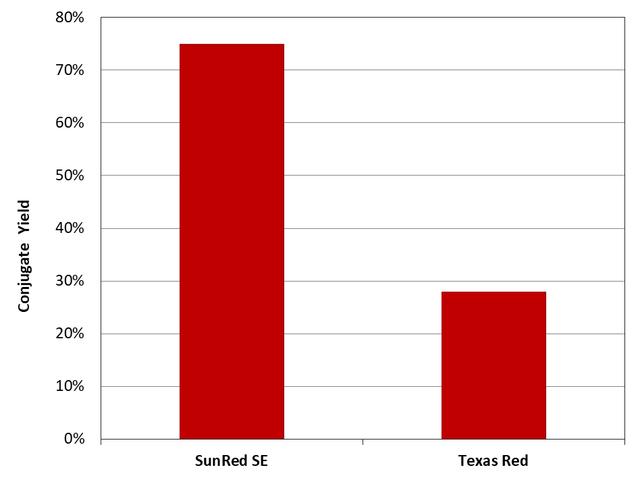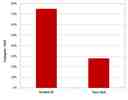SunRed™ SE
Although sulforhodamine 101 acid chloride (also called Texas Red®) is the most popular labeling reagent of sulfonyl chloride, it is quite unstable in water, especially at the higher pH required for reaction with aliphatic amines. Texas Red (TR) reacts with both aliphatic amines and aromatic amines indiscriminatingly. In addition, the labeling efficiency of Texas Red is extremely low compared to dye succinimidyl esters. SunRed™ SE is a succinimidyl ester. It is an excellent replacement for Texas Red. SunRed reacts with amine compounds such as amino acids, peptides and proteins to give bright red fluorescent conjugates that are extremely stable. Compared to Texas Red, SunRed has much higher labeling efficiency, and more importantly the resulted conjugate is more fluorescent and water soluble than the corresponding Texas Red conjugate. The conjugates of SunRed have the identical excitation and emission wavelengths to those of Texas Red. Our in-house studies indicated that SunRed is more stable than Texas Red under the same labeling conditions. It is extremely useful for labeling hydrophobic peptides, giving the fluorescent conjugates that are much easier to be purified and more water soluble to use.
Calculators
Common stock solution preparation
Table 1. Volume of DMSO needed to reconstitute specific mass of SunRed™ SE to given concentration. Note that volume is only for preparing stock solution. Refer to sample experimental protocol for appropriate experimental/physiological buffers.
| 0.1 mg | 0.5 mg | 1 mg | 5 mg | 10 mg | |
| 1 mM | 89.02 µL | 445.101 µL | 890.202 µL | 4.451 mL | 8.902 mL |
| 5 mM | 17.804 µL | 89.02 µL | 178.04 µL | 890.202 µL | 1.78 mL |
| 10 mM | 8.902 µL | 44.51 µL | 89.02 µL | 445.101 µL | 890.202 µL |
Molarity calculator
Enter any two values (mass, volume, concentration) to calculate the third.
| Mass (Calculate) | Molecular weight | Volume (Calculate) | Concentration (Calculate) | Moles | ||||
| / | = | x | = |
Spectrum
Product family
| Name | Excitation (nm) | Emission (nm) | Correction Factor (260 nm) | Correction Factor (280 nm) |
| CDCFDA, SE [5-(and-6)-Carboxy-2',7'-dichlorofluorescein diacetate, succinimidyl ester] *Mixed isomers* | 505 | 526 | - | - |
| DEAC,SE [7-Diethylaminocoumarin-3-carboxylic acid, succinimidyl ester] *CAS 139346-57-9* | 411 | 472 | 0.14 | 0.12 |
References
View all 63 references: Citation Explorer
Fluorescence properties of fluorescein, tetramethylrhodamine and Texas Red linked to a DNA aptamer
Authors: Unruh JR, Gokulrangan G, Wilson GS, Johnson CK.
Journal: Photochem Photobiol (2005): 682
Authors: Unruh JR, Gokulrangan G, Wilson GS, Johnson CK.
Journal: Photochem Photobiol (2005): 682
A comparative study of the potential of solid triglyceride nanostructures coated with chitosan or poly(ethylene glycol) as carriers for oral calcitonin delivery
Authors: Garcia-Fuentes M, Prego C, Torres D, Alonso MJ.
Journal: Eur J Pharm Sci (2005): 133
Authors: Garcia-Fuentes M, Prego C, Torres D, Alonso MJ.
Journal: Eur J Pharm Sci (2005): 133
Bead-based cellular analysis, sorting and multiplexing
Authors: Sanchez-Martin RM, Muzerelle M, Chitkul N, How SE, Mittoo S, Bradley M.
Journal: Chembiochem (2005): 1341
Authors: Sanchez-Martin RM, Muzerelle M, Chitkul N, How SE, Mittoo S, Bradley M.
Journal: Chembiochem (2005): 1341
Transepithelial transport of fluorescent p-glycoprotein and MRP2 substrates by insect Malpighian tubules: confocal microscopic analysis of secreted fluid droplets
Authors: Leader JP, O'Donnell MJ.
Journal: J Exp Biol (2005): 4363
Authors: Leader JP, O'Donnell MJ.
Journal: J Exp Biol (2005): 4363
Purification and fluorescent labeling of the human serotonin transporter
Authors: Rasmussen SG, Gether U.
Journal: Biochemistry (2005): 3494
Authors: Rasmussen SG, Gether U.
Journal: Biochemistry (2005): 3494
Page updated on April 25, 2025



